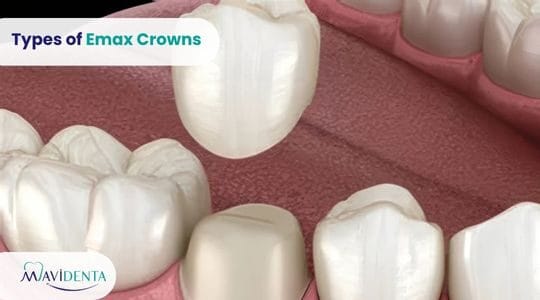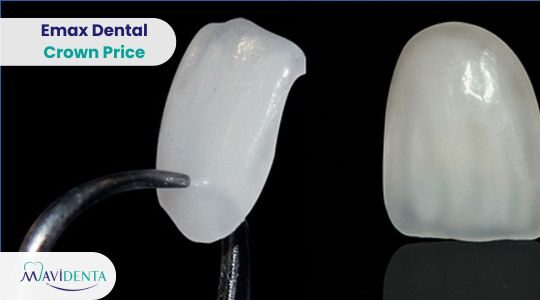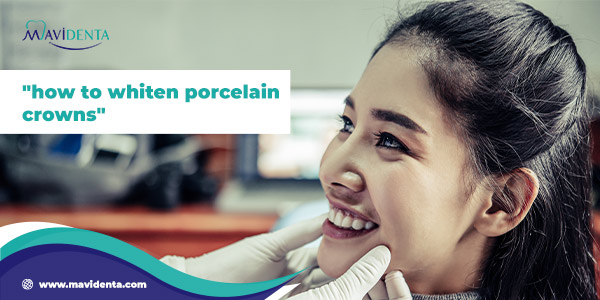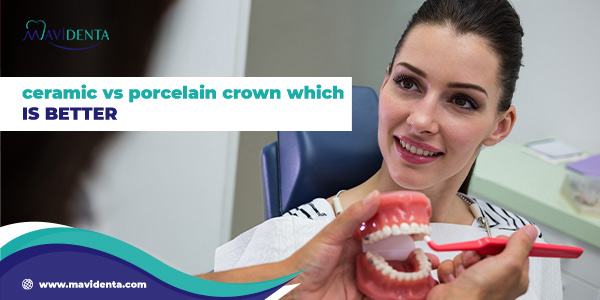In recent times, Emax crowns have become the preferred choice for many dentists and patients, thanks to their superior aesthetics and high strength. With so many different types of Emax crowns available, it’s essential to understand the differences between each type to choose the most suitable for your specific case. Whether you want to restore tooth function or enhance the appearance of your smile, choosing the right type of Emax crown is a vital step toward achieving perfect, long-lasting results.
What Are Emax Crowns?
Emax crowns are one of the newest and best types of porcelain crowns, commonly used in cosmetic and restorative dentistry. These crowns are made from a material known as lithium disilicate, a strong type of porcelain with a high level of translucency and durability, making them suitable for restoring both front and back teeth.
One of the most notable characteristics of Emax crowns is their natural appearance, which matches the color and luster of the original teeth, making them a preferred choice for patients seeking to enhance their smile without compromising strength or performance.
Unlike metal or ceramic-coated crowns, Emax crowns contain no metal, which makes them aesthetically pleasing and visually clear. This prevents gum discoloration or the gray lines that can sometimes occur around traditional crowns. Furthermore, Emax crowns are a biologically safe option, as they are fully compatible with oral tissues and do not cause irritation or sensitivity.
Emax crowns are used in a variety of situations, such as restoring chipped or cracked teeth, covering root canal-treated teeth, improving the shape of irregular teeth, or as part of cosmetic dental restorations that encompass a wide range of procedures. They can also be produced using modern technologies such as CAD/CAM, ensuring high accuracy in measurements and rapid fabrication.
Explore the Zirconium Veneers Price Turkey Affordable Quality

Types of Emax Crowns: Monolithic vs. Layered:-
When it comes to the types of Emax crowns, there are two main types used in cosmetic dentistry: monolithic crowns and laminated crowns. Both types are made from the same primary material, lithium disilicate, but the manufacturing and finishing methods differ, giving each type unique features that meet specific oral needs.
Single-block Emax crowns:
Single-block Emax crowns, also known as Monolithic, are manufactured using CAD/CAM technology. This type is characterized by its high strength and ability to withstand biting and chewing forces, making it ideal for back teeth that are exposed to significant stress.
Although its translucency is slightly lower than that of laminated crowns, modern technologies enable it to be designed in colors that are very close to natural tooth color, making it aesthetically pleasing in many cases.
Layered crowns:
Laminated crowns, on the other hand, are more complexly designed, consisting of a strong Emax core covered by thin layers of cosmetic porcelain. This structure gives the crown a very natural and aesthetic appearance, making it the most suitable choice for front teeth that are visible when smiling or speaking.
Although this type is more susceptible to chipping or erosion due to the multiple layers, its aesthetics are unmatched, especially in cases requiring a precise match to adjacent natural teeth.
Generally, the dentist determines the appropriate type based on the tooth location, the crown’s function, and the patient’s expectations in terms of aesthetics and durability.
If the primary goal is durability and strength, monoblock Emax crowns are usually used, while if a natural appearance and high translucency are the priority, laminated crowns are the ideal choice. In any case, both types of Emax crowns provide a long-lasting, aesthetically pleasing solution that maintains oral health and a beautiful smile.
Also Read: Are Porcelain Crowns Strong? Explained!
Emax CAD vs. Emax Press: Which One Is Better?
Emax crowns are considered a leading option in dental restorations. Their fabrication is usually classified into two main types: Emax CAD and Emax Press. Both types rely on the same base material, lithium disilicate. However, the manufacturing methods and techniques used differ between the two types, affecting their advantages and uses.
Emax CAD crowns:
Emax CAD crowns are produced using the latest digital manufacturing technology known as CAD/CAM. These crowns are digitally designed using a computer program and then precisely cut from a solid ceramic block. This technology offers rapid completion and highly consistent results, minimizing the risk of human error.
Emax CAD crowns are known for their strength and precision and are widely used for urgent restorations or when a patient requires a strong temporary or permanent crown in a short period of time. The CAD/CAM system also provides precise control over the shape and size to match the surrounding teeth.
Emax Press crowns:
Emax Press crowns are manufactured using a heat-pressing technique on the ceramic material. Lithium disilicate is heated and then pressed into a special mold to form the crown. This method is more traditional than CAD/CAM, but it offers exceptional strength and rigidity with a superior aesthetic appearance.
Allowing the technician to add fine details to these crowns. Emax Press crowns also feature a smooth surface and, in some cases, a higher translucency, making them the preferred choice for front teeth requiring a very natural appearance.
When it comes to preference, one type cannot be said to be completely superior to the other; the choice depends on the clinical situation and the patient’s requirements. If speed and digital precision are paramount, Emax CAD crowns are an excellent choice.
However, if aesthetics and a high-quality finish are the focus, Emax Press crowns may be a more suitable option. Cost also plays a significant role, as Emax Press crowns may be more expensive due to the manual labor and skill required in their manufacture.
Ivoclar Emax Crowns and Veneers Explained:-
Ivoclar Emax is a leading name in the manufacture of porcelain crowns and veneers used in cosmetic and restorative dentistry. These products are based on advanced technology based on lithium disilicate, a ceramic material characterized by high strength and durability.
As well as translucency and a natural aesthetic. Therefore, Ivoclar Emax crowns and veneers are the preferred choice for many dentists and patients seeking to permanently and effectively improve the appearance and function of their teeth.
Ivoclar Emax crowns are full crowns that cover the entire tooth to protect and restore it. They are often used for severely damaged teeth, those that have undergone root canal treatment, or for restorations that require full coverage. These crowns are highly resistant to breakage and wear, and they mimic the color and translucency of natural teeth, making them appear very natural when smiling or speaking.
Ivoclar Emax veneers are ultra-thin layers bonded only to the front surface of the tooth to improve its appearance, color, or correct minor imperfections such as uneven size or gaps between teeth.
These veneers offer a quick way to achieve a perfect smile without requiring major changes to the tooth structure. Made from the same material as lithium disilicate, Ivoclar Emax veneers offer a natural appearance and translucency similar to real teeth.
The strength of Ivoclar Emax products lies in the perfect balance between durability and aesthetics. Not only are they resistant to the pressure and mechanical forces caused by chewing, but they also retain their color and shine for a long time without discoloration or yellowing.
Furthermore, these crowns and veneers are manufactured using modern technologies such as CAD/CAM, which ensures high design precision and a perfect fit, reducing the risk of error and resulting in consistent results.
Also Read: Full Set of Crowns Cost Turkey | Types and Benefits

Do Emax Crowns Look Natural and Translucent?
Emax crowns are one of the most popular types in cosmetic dentistry, primarily due to their natural appearance and high translucency. These crowns are made from lithium disilicate glass, a ceramic material characterized by durability and strength, as well as translucency and shine that mimics the appearance of real teeth.
Emax crowns are characterized by their high light transmission, giving them a translucency that is very close to that of natural teeth. This feature makes crowns appear natural and unnatural when smiling or speaking, even under direct light. Thanks to this transparency, the dentist can determine the appropriate shade to perfectly match the color of the adjacent teeth, enhancing visual harmony and making the crown appear almost invisible.
Furthermore, Emax crowns can be designed to incorporate natural color gradations, including shades and accents found in real teeth, such as subtle veining or color contrast between the center and edges of the crown. All of this helps achieve a very natural smile, without any artificial appearance.
It is important to note that crowns made from other materials, such as hard zirconia, may be less translucent, making them appear harder and less natural, especially on front teeth that need a natural, attractive appearance. On the other hand, Emax crowns combine strength and aesthetics, making them the ideal choice for those seeking a natural appearance with exceptional translucency.
What Is the Life Expectancy of Emax Crowns?
Emax crowns are a prominent choice in cosmetic and restorative dentistry, combining a natural aesthetic with high durability. Many patients ask about the lifespan of these crowns, wondering whether they will last long or require immediate replacement.
In general, the lifespan of Emax crowns can vary depending on several factors, but they typically last between 10 and 15 years, and can sometimes last longer if proper care is followed. This lifespan is considered excellent compared to other types of crowns and reflects the quality of the materials and manufacturing techniques used. Several factors affect the lifespan of Emax crowns:
Oral Hygiene:
To prolong the lifespan of crowns, it is important to maintain good oral hygiene. Brushing your teeth twice daily, flossing, and regular dental visits play an important role in preventing the buildup of bacteria that can lead to gum problems or tooth decay under crowns.
The skill of the technicians who install them:
The success of a crown depends on the precision of the design and installation by the dentist and laboratory technician. The use of modern technologies such as CAD/CAM helps create crowns that appear perfectly aligned with the teeth, reducing the possibility of leakage or separation.
Crown Placement:
Crowns placed on the front teeth are subject to less pressure than those on the back teeth, which may help extend their lifespan. Crowns on the back teeth, however, are subject to higher chewing pressure and require special treatment.
Patient’s Daily Habits:
Some habits, such as teeth grinding, chewing hard objects, or eating hard foods, can damage crowns and reduce their lifespan. A night guard is recommended to protect crowns in cases of teeth grinding.
General Health:
Some chronic diseases or gum problems can negatively affect the stability of crowns and reduce their lifespan.
When carefully placed and properly cared for, E-max crowns retain their original color and shine and continue to provide effective support for the teeth. Although some cases may require replacement or modification of crowns over time, they often last long enough to meet the patient’s aesthetic and functional needs.
Also Read: Ceramic Vs Porcelain Crown Which Is Better To Perfect Smile
Disadvantages of Emax Crowns: What You Should Know:-
Although Emax crowns are very popular due to their natural appearance and strength, it’s important to be aware of some disadvantages or limitations that can influence your decision to use them in certain situations. In this article, we’ll discuss the most prominent disadvantages of these crowns in detail.
1. Lower Strength Level than Other Materials:
Although Emax crowns are strong, their durability is not as strong as that of zirconia crowns. Therefore, they may not be the best choice for back teeth that experience significant chewing pressure or frequent teeth grinding. Consequently, the crown may be more likely to break or wear down more quickly than some other materials.
2. Risk of Chipping or Fracture in Laminated Crowns:
Laminated crowns contain a thin outer layer of cosmetic porcelain, and this layer may be susceptible to chipping or chipping over time, especially when exposed to significant stress or unhealthy habits such as biting hard materials. This means that maintenance or replacement may become necessary after a while.
3. Relatively High Cost:
Emax crowns are considered medium to high-cost compared to other types, such as metal or composite crowns. The high production costs and advanced technology used in their manufacture contribute to the higher final price, which may be a deterrent for some.
4. Requires Precise Tooth Preparation:
To ensure the best results with Emax crowns, the dentist must carefully prepare the teeth to ensure the crown fits properly without any gaps that could allow bacteria or decay to enter. This process requires a high degree of skill and experience, and if not performed properly, future problems may occur.
5. Possible Sensitivity After Placement:
Some patients may experience temporary sensitivity after receiving Emax crowns, especially if the crown covers a tooth that has recently undergone treatment or if nerves were exposed during preparation. This sensitivity is usually temporary and resolves over time, but it may cause discomfort for patients initially.
6. May not be suitable for some cases:
In some cases, such as teeth that need additional support due to significant bone loss or gum problems, Emax crowns may not be the best option. In these circumstances, your dentist may prefer to use harder materials such as zirconia or metal crowns.
Emax vs. Zirconia Crowns: Pros and Cons:-
1. Materials and Composition:
- Emax crowns: Made from lithium disilicate glass, a ceramic material that combines translucency with natural beauty.
- Zirconia crowns: Made from zirconium oxide, a very strong ceramic metal with high hardness.
2. Beauty and Natural Appearance:
- Emax: Offers high translucency similar to natural teeth, with a variety of color shades that can be precisely matched to the original teeth.
- Zirconia: Less translucent than Emax, so crowns may appear harder and less natural, especially on front teeth.
3. Durability and Strength:
- Emax: Strong and durable, but less rigid than zirconia, making it more suitable for front teeth or areas that are not subject to high stress.
- Zirconia: Extremely hard and highly resistant to pressure and mechanical forces, making it ideal for back teeth that withstand significant chewing forces.
4. Corrosion and Fracture Resistance:
- Emax: May be more susceptible to chipping or chipping, especially laminated crowns, but it offers a good balance between aesthetics and durability.
- Zirconia: Less susceptible to corrosion or chipping, it is one of the most durable materials used for crowns.
5. Tooth Preparation and Crown Placement:
- Emax: Requires careful tooth preparation to ensure a perfect fit.
- Zirconia: Due to its strength, it can be thicker, which may require the removal of more tooth structure during preparation.
6. Cost:
- Emax: Emax crowns are typically moderate to high in cost, due to the materials and techniques used.
- Zirconia: Its cost may be slightly higher than E-max, especially for multi-layered crowns or crowns with an aesthetic layer.
7. Ideal Uses:
- E-max: Suitable for anterior teeth requiring aesthetics and high translucency.
- Zirconia: Ideal for posterior teeth or cases requiring high strength and resistance.
Also Read: Difference Between Ceramic and Porcelain Dental Crowns
IPS Emax vs. Zirconia: Which Should You Choose?
When considering dental restorations with crowns, many doctors and patients are faced with two main options: IPS Emax and zirconia. Both are excellent crown materials, but each has its own unique characteristics that make them different from each other. This leads to a decision based on clinical, aesthetic, and functional factors.
IPS Emax crowns:
First, IPS Emax is a crown made of lithium disilicate porcelain, a material known for its ability to blend the natural shape of teeth with the required strength. What distinguishes IPS Emax crowns is their high translucency.
Which mimics the appearance of natural teeth, making them the ideal choice for anterior teeth that require exquisite aesthetics and natural transparency when smiling or speaking. Furthermore, this material offers excellent aesthetic quality, as the doctor can precisely select the color and gradation to match the adjacent teeth.
However, IPS Emax crowns are less durable than zirconia crowns, as they are prone to breaking or cracking when subjected to heavy chewing pressure or habits such as teeth grinding. Therefore, they are particularly preferred for use in anterior areas or areas that do not experience significant stress.
zirconia crowns:
On the other hand, zirconia crowns are made from zirconium oxide, a very strong ceramic material. Zirconia is known for its strength and hardness, making it ideal for posterior teeth that are subjected to significant chewing pressure.
Zirconia also withstands heavy use better and is highly resistant to breakage and wear, making it a good choice for patients with habits such as teeth grinding.
Average Cost of Emax Crowns in 2025:-
Emax crowns are one of the most popular and high-quality options in cosmetic and restorative dentistry, offering an excellent balance between natural aesthetics and high durability.
With the advancement of technology and increasing demand, the question of what the cost of installing these crowns will be in 2025 has arisen, given that prices vary based on geographic location, the experience of the dentist, and the quality of the materials used.
In general, the average cost of an E-max crown in 2025 ranges between $300 and $800 per tooth in many countries. This significant price variation is due to several factors that affect the final cost, including:
Location of the clinic and country:
The country or city in which the treatment is performed is a factor that influences the cost. For example, the cost of E-max crowns in countries such as Western Europe or North America may be significantly higher than in developing countries or some Asian countries. The standard of living and healthcare services in the region also affect the price.
Experience of the doctor and technician:
The cost of installation increases with the experience of the dentist and the skill of the technician who produces the crowns, as quality and precision play a key role in the success of the work and patient satisfaction.
Crown Type and Production Technique:
The prices of crowns manufactured using CAD/CAM technology differ from those manufactured using press technology. The former are usually lower due to faster production and reduced manual labor.
Tooth Condition and Treatment Needs:
Sometimes, additional dental treatment, such as root canal treatment or special preparations, is required, which increases the overall cost of treatment.
Aesthetic Technologies and Additions:
Some patients may require advanced techniques or additional materials to enhance the final appearance, such as hand-coloring or laminates, which affect the price.
It is important to note that countries such as Turkey and Mexico offer E-max crown installation services at competitive prices and high quality, making them preferred destinations for dental medical tourism.
Although the cost of E-max crowns may seem higher compared to some traditional types, they represent a long-term investment in dental health and aesthetics. Crowns made of lithium disilicate offer good resistance to wear and fracture, as well as a natural appearance that lasts for a long time with proper care.
Also Read: Full Set of Crowns Cost Turkey | Types and Benefits
Can Emax Crown Treatment Be Completed in One Day?
Emax crowns are one of the most common cosmetic and restorative procedures in dentistry. Many patients seek to complete this treatment in one day due to time pressure or the need for quick results.
Fortunately, thanks to the significant advancements in modern dental technology, this has become possible in many cases. Emax crown treatment can be completed in one session or on the same day, thanks to advanced technologies such as CAD/CAM.
CAD/CAM technology relies on dentists taking digital scans of teeth, designing crowns using advanced computer software, and then fabricating them directly in the clinic or laboratory within a few hours.
This allows modern dentists to place Emax crowns in one session, eliminating the long waiting periods that were previously required. Another benefit of this technology is its high precision, as the crown is designed to perfectly fit the shape and size of the surrounding teeth, enhancing aesthetic and functional results.
However, it should be noted that completing Emax crown treatment in one day may not be suitable for all cases. Some teeth may require specific preparation or additional treatments, such as root canal therapy or a deep cleaning of the gums, which may mean postponing the placement of a crown until a later appointment. Cases requiring precise adjustments or the placement of a cosmetic veneer may also require longer.
The success of rapid treatment also depends on the competence of the dentist and the quality of equipment available at the clinic. Advanced clinics that use CAD/CAM technology and have an in-house laboratory can easily perform Emax crown installation on the same day, while traditional clinics may take a week or more to fabricate.
Discover the Cost of Zirconium Crown.
Caring for Your Emax Crown: Tips for Long-Lasting Results:-
Maintaining Daily Oral Hygiene:
Brushing your teeth twice a day and flossing daily helps remove plaque and bacteria that can accumulate around the crowns. This helps prevent cavities or gingivitis that may occur under or near the crowns.
Visiting the Dentist Regularly:
Scheduling your dentist every six months allows for early detection of any potential problems with the crowns or adjacent teeth, such as cavities or crown displacement. This contributes to early prevention and treatment.
Avoid Bad Habits:
Refrain from nail biting or biting hard objects such as pens or ice, and reduce teeth grinding, as this can lead to breakage or damage to the Emax crown.
Avoid staining foods and drinks:
You should reduce your consumption of staining foods and drinks, such as coffee, tea, red wine, and smoking, to maintain the shine of your crowns and prevent discoloration over time.
Use a mouthguard when needed:
If you suffer from teeth grinding while sleeping, it’s recommended to wear a mouthguard while sleeping to protect your crowns from damage or breakage caused by constant pressure.
Avoid excessive pressure on your crowns:
It’s important not to use your teeth to open objects or bite down on non-food items, as this can damage or dislodge the crowns.
Follow your dentist’s specific instructions:
Following your dentist’s advice on personal care and the specific instructions for each patient’s case helps preserve your crowns for as long as possible.
When Do You Need an Emax Crown?
Severe Tooth Damage:
When teeth are chipped or cracked, or if there is deep decay affecting the strength of the tooth, an Emax crown is necessary to protect them and restore their shape and function.
After Root Canal Treatment:
Teeth that have undergone root canal treatment are more susceptible to fracture, making an Emax crown essential to strengthen and protect them from future damage.
Correcting Cosmetic Imperfections:
If you have irregularly shaped teeth, discolored teeth, or uneven teeth, Emax crowns can be used to improve the overall appearance of your teeth and create a more attractive smile.
Covering Large Fillings:
When there are large fillings in a tooth, the tooth structure may not be sufficient to support the filling alone. Therefore, an Emax crown is installed to provide additional support and overall protection.
Supporting Dental Bridges:
When bridges are installed to replace missing teeth, Emax crowns are used on adjacent teeth as abutments due to their strength and natural appearance.
Front Teeth Needing High Aesthetics:
Thanks to their translucency and natural appearance, Emax crowns are the ideal choice for a stunning smile and for front teeth that require high aesthetics.
What Is the Most Natural-Looking Dental Crown?
In the field of cosmetic and restorative dentistry, patients always seek dental crowns that not only preserve the health and function of their teeth but also provide them with a natural and attractive appearance that closely resembles real teeth. How can you achieve a more natural-looking crown?
E-max crowns are among the most popular options due to their natural appearance and high translucency that mimics real teeth. These crowns are made from lithium disilicate glass, a ceramic material that combines strength and durability with aesthetics and translucency.
This material’s ability to transmit light makes the crowns appear like a natural tooth, with a variety of colors and shades that match the surrounding teeth. The lab staff can also precisely customize the crown, adding subtle gradations in color and shape to mimic real teeth, even in small details such as veins and shine.
On the other hand, there are crowns made from zirconia, which have a high hardness, but their translucency is lower than that of E-max, which can make them appear less natural, especially on front teeth that require an aesthetic and transparent appearance. However, zirconia manufacturing techniques are constantly evolving, and multi-layered types have emerged that mimic the appearance of natural teeth better than ever before.
There are also crowns made of porcelain laminated over metal, which have been a traditional choice for many years. While they offer good strength, the presence of metal under the porcelain layer can negatively affect the translucency and aesthetics, making them appear less natural. Metal lines can also appear at the edges of the crown over time.
Also Read: Zirconium Crowns vs. Veneers
Does an Emax Crown Change Color Over Time?
Emax crowns are a premium option in cosmetic dentistry, boasting natural features and a translucency that closely resembles the original shape of the teeth. However, many patients ask: Will the color of these crowns change over time? Will they lose their luster with repeated use?
To begin, it’s worth clarifying that Emax crowns are made of lithium disilicate glass, a high-quality ceramic material known for its better stain resistance than other materials, such as resins or porcelain-covered metal crowns.
Thanks to the properties of this material, E-max crowns do not absorb colors easily, which means they are less likely to yellow or change color over time. However, there are some factors that can indirectly affect the appearance of a crown and make it look different:
Staining:
Although materials are resistant to staining, plaque buildup, stains from beverages such as coffee, tea, or red wine, or even smoking, can discolor the crown’s outer surface, affecting its luster and dulling its brightness. These stains can usually be removed with a professional cleaning at a dentist.
The condition of the gums and surrounding teeth:
Changes in the color of the gums or adjacent teeth can affect how the crown color is perceived. For example, if nearby teeth show yellowing or decay, the crown may appear a different color.
Cracked or worn crown:
In rare cases, if a crown has been worn or cracked, its color may change, or it may appear uneven.
Quality of workmanship and installation:
The precision of the manufacturing and installation process affects the stability of the crown color. Crowns made with precision and high-quality techniques are better able to maintain their appearance for long periods.
On the other hand, maintaining dental hygiene through regular brushing and flossing, in addition to regular visits to the dentist, helps preserve the color and shine of crowns. It is important to avoid habits that may cause staining, such as smoking or excessive consumption of colored beverages.
Best Clinic for Emax Crown Treatment in Turkey:-
When it comes to obtaining high-quality Emax crowns, Turkey is one of the world’s leading countries in cosmetic and restorative dentistry. Among the excellent clinics that stand out for providing precise and professional Emax crown installation services is Mavidenta.
Mavidenta is a comprehensive medical center with highly experienced dentists specializing in modern dental restoration techniques. The clinic uses the latest digital equipment and technologies, such as CAD/CAM and digital design, ensuring the manufacture of precise Emax crowns that perfectly fit the patient’s oral structure, providing a natural appearance and transparency resembling real teeth.
What distinguishes the Emax crown service at Mavedanta is its strong focus on the quality of the materials used. The clinic uses the finest, internationally certified lithium disilicate glass, ensuring the strength and longevity of the crowns while maintaining a distinctive appearance. The medical team is also committed to custom-designing crowns for each case to ensure patient comfort and natural tooth function.
Explore the Best Dental Implant Clinic in Istanbul.
Conclusion
Emax crowns are an excellent option for people who desire a combination of natural beauty and longevity. Through discussion with your dentist, you can choose the most appropriate type of Emax crowns based on your needs. Don’t hesitate to take this step, which can permanently transform your smile and give you new confidence every day.
FAQs
What is the concept of Emax crowns?
Emax crowns are made of lithium disilicate, a high-quality ceramic material, and are characterized by their strength and translucency, resembling real teeth.
What are the most popular types of Emax crowns?
- Emax Press: These are produced using a press technique and are known for their high precision.
- Emax CAD: These are manufactured using CAD/CAM technology and are suitable for cases requiring rapid placement.
- Emax Layered: In this type, the crown is covered with aesthetic layers for a more natural appearance, especially for front teeth.
What is the difference between Emax and zirconia?
Zirconia is considered stronger and is typically used on posterior teeth, while Emax crowns are more commonly used on anterior teeth due to their natural aesthetics and translucency.
Can the different types of Emax be used on all teeth?
Most types of Emax crowns can often be used on anterior teeth and some posterior teeth, but the dentist determines which is most appropriate based on the location and strength of the application.
How long do Emax crowns last?
They typically last between 10 and 15 years or more, provided you maintain good oral hygiene and visit your dentist regularly.







